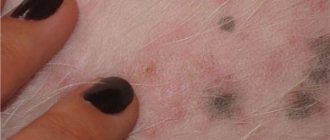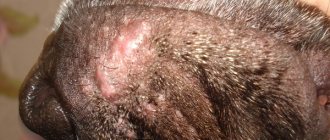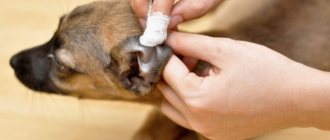Fleas can be safely described as the most annoying and widespread parasites, which consider dogs, other domestic animals, and, in the absence of such, humans as food sources. There is a widespread belief in everyday life that dogs living in outdoor conditions are especially susceptible to flea infestation.
In fact, all dogs are considered at risk, including those that live in an apartment and have virtually no contact with their brothers. When fleas appear, the animal is bothered by severe itching and pain; in addition, infection with parasites can cause the development of severe infectious diseases carried by these unpleasant insects.
If larvae and adult fleas are found on an animal's fur, for example, while bathing, you should immediately begin treating the animal. We will consider below which methods are particularly effective.
Chemical pest control agents
It is generally accepted that fleas on a dog, especially one that lives in an enclosure or kennel, are a fairly common problem that does not require mandatory elimination. The above misconception can be safely called fundamentally incorrect. Infecting a dog with fleas can cause more than just severe itching.
The main danger posed by these insects is the risk of infection with infectious diseases, helminths, and hair loss is also possible. In weakened animals, puppies, fleas can cause the development of anemia.
In order to avoid such unpleasant consequences, it is important to take timely care of the dog’s health. First of all, it is important to remove fleas from fur through the use of various special products. Next, you need to completely replace the animal’s bedding and disinfect the booth or enclosure. Only with the gradual removal of parasites can you completely rid the animal of an unpleasant neighborhood.
Shampoo
Anti-flea shampoos are among the products that have a low level of effectiveness. It is recommended to wash the animal with their help only to prevent the appearance of parasites or when there are very small numbers of them. It is important to know how to properly treat your dog for fleas.
Apply the shampoo evenly to the dog’s wet coat, leave for a few minutes, and rinse. It is recommended to use such products comprehensively, combining them with more effective anti-flea medications. The following types of shampoos are especially popular: Celandine, Doctor Zoo.
Spray
Dog fleas are quite sensitive to insecticidal chemicals available in spray form. Aerosols such as Bars and Frontline will help quickly rid the animal of parasites. They can also be used for preventive purposes. It is recommended to remove fleas from a dog by applying a toxic aerosol to the animal’s withers, and it is important to ensure that the poison does not get into the mouth or mucous tissues.
It is advisable to carry out the procedure outdoors. This will help prevent accidental intoxication from toxic fumes.
Drops
Effective, long-lasting flea treatment for dogs can be carried out using a variety of drops, such as: Frontline, Advocate, Celandine, Fleanet. In order to know what is the best way to treat your dog against fleas, it is recommended to consult a veterinarian who will select the most suitable products for a particular animal, corresponding to the weight, breed, and age of the dog.
Using drops is more than simple. To do this, just apply the required amount of product to the pet’s withers area. After the procedure, you should not bathe the dog for two to three days. The antiparasitic effect from the use of drops lasts for a month . After the specified period of time has expired, re-processing must be done.
Pills
When thinking about how to get rid of dog fleas, you can consider an option such as using special chewable tablets. These products are not highly effective; they are recommended to be used only when there are a small number of parasites.
In addition, they do not have a detrimental effect on insect eggs, meaning there is a high probability of re-infection. Due to the almost complete safety of the medicine, the tablets can be used to treat weakened animals, small puppies.
Powder
If a dog flea has attacked puppies less than 1 month old, it is recommended to treat the animal with a special powder made in a veterinary pharmacy. This remedy is absolutely safe and can be used to treat weakened animals. However, to achieve a positive effect, regular procedures will be required for at least two weeks.
Collar
The most popular, easy-to-use flea control for dogs are various collars. To completely kill fleas, just put the collar on the animal, adjusting the length of the accessory if necessary.
The collar can maintain a therapeutic effect from several weeks to several months, this aspect depends on the specific toxic substances that were involved in the manufacture of the flea product.
Collars: which one to choose
Opinions are divided regarding the use of collars. Some people are sure that they can’t do without them, while others think that it’s a waste of money.
There are several facts about how to make the most effective use of a collar.
There are three types of collars: chemical, biological and ultrasonic. Chemicals contain strong substances, the smell and action of which repel parasites. Collars must be used after disinfection, otherwise fleas can move to the dog’s back and tail, where the collar’s action is not enough.
Article on the topic: Flea and tick collar for dogs
Biological collars do not have a strong and repulsive odor; the positive effect is caused by medicines and essential oils. Recommended for sick or old dogs and puppies.
Ultrasonic collars are considered universal; the operating principle is that ultrasonic waves create an uncomfortable atmosphere for parasites. An expensive pleasure, the effectiveness of which is questioned.
Folk remedies
If the use of chemicals is not possible for any reason, it is recommended to pay attention to tips on how to rid your dog of fleas using folk remedies. There are a lot of fairly effective, safe recipes that will help eliminate parasites and also improve the dog’s condition.
Laundry soap
You can quickly rid your dog of fleas and also destroy parasite eggs using homemade soap. To make this product, you should grate one block or grind it in another way, then pour two glasses of boiling water.
Mix the mixture thoroughly until a mass has a homogeneous consistency. To enhance the effect, it is recommended to add a few drops of eucalyptus and tea tree essential oil.
The resulting medicine should be thoroughly washed by the dog. Fleas with this treatment completely disappear after just a few days of regular treatment.
Essential oils
Highly effective folk remedies for dog fleas also include essential oils that have distinct, bright odors. Extracts of citrus fruits, mint, and eucalyptus are best suited.
To obtain the desired effect, apply a small amount of oil to the animal’s withers. You can also treat your dog's bedding with the product.
Herbs
The simplest remedy against fleas on dogs is wormwood. Parasites cannot tolerate its unpleasant, very rare smell . In order to remove fleas from dogs at home, it is recommended to thoroughly wash your pet several times using a rich decoction of wormwood. It is important to ensure that the broth does not get into the animal’s mouth, as this can cause severe poisoning.
Garlic
At home, it is quite possible to prepare your own simple, safe, but effective flea remedy for dogs. To do this, cut one large head of natural garlic into small slices, then steam it with a glass of boiling water.
Let the resulting medicine brew for several hours. Apply garlic infusion to all areas that the dog cannot lick, that is, the withers and crown.
Onion
Folk remedies for fleas on dogs often involve the use of regular onions. This vegetable will help eliminate even a huge number of parasites. To prepare the medicinal mixture, you should prepare a soap solution, based on ordinary laundry soap, and then add a head of onion, grated with a grater.
Apply the finished mixture to the dog’s fur, leave it for a while, and then rinse it off using not only water, but also shampoo. If your dog constantly walks outside, it is recommended to regularly treat the animal’s fur with this product . This will help significantly reduce the risk of infection.
Needles
Fighting fleas in dogs includes treating not only the animal, but also the place where the dog spends most of his time, for example, the bedding or kennel. In order to prevent multiple re-infections, you need to know what exactly fleas are afraid of. And these parasites, as a rule, cannot tolerate strong odors.
In order to remove parasites from the kennel, you need to throw out the old bedding, and then line the bottom of the dog’s home with a thick layer of pine branches. You can place bedding on this unique coniferous feather bed. Additionally, it is recommended to apply a small amount of pine essential oil to the animal’s booth or bedding. This measure will also help repel parasites.
Vinegar
The most popular remedy recommended by treating veterinarians is ordinary table vinegar or another type of vinegar. To get rid of dog fleas, it is recommended to dilute a few tablespoons of the product in a glass of warm water, and then treat the pet’s fur with this solution. However, the procedure does not end there . To remove fleas from your dog, you need to thoroughly comb out the dog's fur after applying vinegar.
In addition, you can also use vinegar to treat the animal's kennel or bedding. This measure will help significantly reduce the likelihood of re-infection. Due to the fact that vinegar has a very strong, unpleasant odor, after treating the litter you should wash it thoroughly and also dry it outside.
It must be remembered that a one-time vinegar therapy may not bring the expected result if there are a large number of parasites on the dog’s fur. To completely remove them, it may take three to ten treatments.
When should you use powders?
The advantage of this method is that it is safe and will not harm the health of the animal or your family. Powders are often prescribed to puppies, less often to adult dogs. They can be purchased at any pharmacy.
How to use:
- Sprinkle flea powder for dogs on all of your pet's common areas where fleas are suspected of being present.
- Every three or four days, wet clean and add new powder.
- Removing parasites using powders will last about three weeks. The length of the process is a disadvantage.
Powders will affect not only living individuals, but also larvae. All parasites will be destroyed, powders are an effective and cheap, but not always the fastest method.
Features of flea removal in puppies
A particularly important measure is treating your puppy against fleas. Unreasonable actions can cause poisoning of the baby, and in severe cases, his death. In order to prevent this, it is recommended to consult a veterinarian if your puppy has parasites. A specialist will help you choose the optimal treatment method.
Up to a month
Fleas in a puppy less than a month old can cause the animal to develop serious illnesses. What to do if your dog has parasites? To kill insects, it is recommended to use the safe folk remedies given above. To prevent re-infection, it is recommended to treat not only the puppies, but also the mother.
1 month
But how to remove fleas from a 1 month old puppy? It is best to use mild anti-flea shampoos for this purpose, which will help remove parasites. However, to completely eliminate them, it is important to be patient, since the procedure must be carried out for at least two weeks. At the same time, you should regularly comb the animal’s fur.
2 months
Fleas can be removed from a 2-month-old puppy by using special shampoos and collars. In order to reduce the risk of infection, it is recommended to use anti-parasitic shampoos on a regular basis.
Also, one should not forget about the cleanliness of the animal’s fur; it must be constantly combed.
Prevention
To ensure that fleas visit your dog much less often, you must follow these rules:
- Periodically disinfect the room, change and wash sleeping places;
- Vacuum carpets, cracks in the floor, burn disposable dust containers, and put an anti-flea collar in a reusable one;
- Keep contact with other animals to a minimum;
- Monitor your pet's behavior;
- Brush his coat regularly, preferably with a flea comb or a metal comb with firm, fine-toothed teeth;
- Walk in specially designated areas;
- Keep calamus leaves or branches of wormwood and tansy in the corners of the house, but only if the pet does not have allergies;
- Ventilate the house in winter - fleas cannot stand the cold;
- During the summer months, wear a flea collar before going for a walk;
- Be sure to examine the dog after mating or upon returning from a show.
If fleas are found on one of your pets, you will have to treat every single one of them, even if they show no signs. This is a necessary part of prevention.
Some owners begin to fight parasites only if they have already multiplied with might and main. They believe that fighting small insects is the same as going to drink tea. Indeed, sometimes this turns out to be simple, especially if the house is small and there is only one dog living in it. But we must remember that the struggle is not always easy, and the pet can literally experience agony.
Taking flea prevention is the responsibility of every dog owner.
Signs of a pest
In order to quickly and effectively remove parasites, you need to find out in a timely manner that your dog has fleas. There are several main signs that may indicate that an animal is infected.
The main ones are the following:
- The dog is bothered by constant itching and pain, and the animal’s behavior changes accordingly.
- When a huge number of parasites appear on the animal’s fur, the dog’s condition rapidly deteriorates. There is a lack of appetite, weakness, and lethargy.
- On the animal’s fur you can see white, dark dots, which represent eggs, larvae, and adult parasites.
It is also recommended to know what a dog flea looks like. This is a small insect, no more than three millimeters long, with a dense shell, powerful hocks, and six pairs of legs. The color of the parasite can vary from yellowish to distinct brown.
Premises treatment
If the dog lives at home, it is necessary to treat all rooms, furniture and carpets, not forgetting the pet’s belongings (including soft toys). For an animal kept in an enclosure, the booth, bedding and other household items are disinfested. Without treatment, treatment becomes pointless, since flea eggs remaining in the house remain viable for up to two weeks.
Apartment cleaning
There are several ways to destroy insects in a house or apartment :
- Skirting boards, carpets, furniture, and ventilation holes are treated with special sprays. Sometimes re-treatment is required after 7-10 days.
- Folk remedies: wormwood, tansy or lavender are placed around the house. Another option is to wash the floors daily for 10 days with the addition of essential oils of eucalyptus, lavender, and citrus.
- Exposure to low temperatures - in winter, you can leave the windows open for 4-6 hours and leave the house.
- Calling exterminators is an extreme case when fleas have spread throughout part of an apartment building.
After any type of treatment, it is necessary to vacuum furniture and carpets, wash all surfaces and floors, and boil textiles. This will destroy the surviving larvae and adults.
Cleaning the booth
There are no fundamental differences in the treatment of a booth and an apartment: the bedding is taken out and boiled (although it is better to throw it away and buy a new one), the inside of the house is sprayed with insecticides, and then washed with water and essential oils.
For the first time (up to a month), you can spread fresh tansy or wormwood around the enclosure. If it is winter, then such measures are unnecessary.
Precautionary measures
Chemical poisoning is an extremely unpleasant phenomenon. To avoid it, you need to protect yourself while processing the room:
- wear gloves and cover your face - with a scarf, respirator, medical mask;
- protect your eyes with glasses;
- read the instructions carefully, avoid overdoses and use of expired products;
- remove all household members for a while - it is better if animals, children, elderly people and family members with chronic diseases stay outside the apartment for at least a day;
- after the procedure, take a bath, wash your hands thoroughly;
- Ventilate the room well after treatment and wash all surfaces with clean water.
If an allergy or poisoning occurs due to the use of the products, you must go to the hospital.
Answers to popular questions
Probably, almost every dog owner, when parasites appear in an animal, is interested in the following questions: how quickly fleas reproduce, what types of fleas can be found in dogs. As mentioned above, insects are not particularly picky in their diet; therefore, a dog can be attacked directly by dog fleas, rat fleas, human fleas, and many others. However, regardless of the species of insects, it is recommended to use similar preparations to remove them.
How does a pet become infected?
To somewhat protect your pet from parasite infection, it is important to know where fleas come from in dogs. More often, infection occurs through close contact between animals, for example, during play or fighting. However, there are many other ways. So, danger can lie in wait for a dog on the grass, earth, sand. Insects, falling from an infected animal into the external environment, can remain viable for a very long time.
Even if the animal practically does not go out for street walks (more often, keeping it exclusively in an apartment is necessary for puppies that do not have all the necessary vaccinations, as well as small breed dogs), there is a risk of infection.
This can happen upon contact with the owner's street shoes or the wheels of a baby stroller. That is, there are an incredible variety of ways to infect a dog with fleas.
Are fleas dangerous for humans?
Dog fleas may well pose some danger to humans. These parasites are not selective in their nutrition, that is, in the absence of an animal, they may well be considered a source of human nutrition.
Since fleas are carriers of serious diseases of infectious etiology, a parasite bite can cause the development of such dangerous ailments as typhoid, salmonellosis, and various types of helminthiasis. In order to avoid infection, you should begin removing parasites from an animal immediately after detecting signs of infection.
Danger to dogs
For animals whose body is covered with abundant fur, a flea bite is potentially dangerous. These small and seemingly harmless jumping insects inject their saliva into the wound of the bitten person.
Such an “injection” can lead to a number of pathologies:
- excessive hair loss;
- severe itching and redness of the skin in the bite area;
- infection with worms (occurs if a cat or dog accidentally eats a flea);
- transmission of viruses;
- bacteria entering the wound that provoke an allergic reaction;
- in especially severe cases, anemia is observed, which threatens the life of the animal.
A dog attacked by fleas begins to itch intensely, which causes the pet many unpleasant moments. Scratched areas of the skin often become inflamed and cause skin diseases.
Moving from an infected animal to a healthy one, fleas quickly multiply and begin to drink the blood of a new owner. Insect activity increases sharply in spring or autumn.
On a note . Fleas practically do not parasitize humans and are not transmitted to them from pets. As a rule, humans are too hairless for these insects, so the parasites are not found on the human body. However, the risk of flea infestation still exists.











